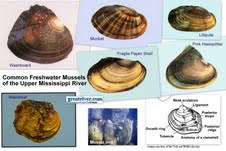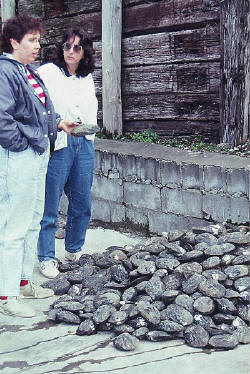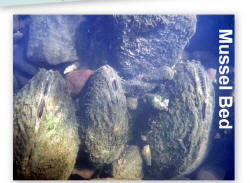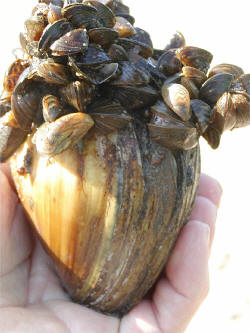Table of
Contents
Marian Havlik's 10 grandchildren seldom
find grandma making chocolate chip cookies or teaching them how to knit.
Instead, they wend their way past stacks of specimen boxes, and scientific
reports for a lesson on the new computer.
Their grandma, known from St. Paul,
Minnesota, to Mobile, Alabama, simply as "that clam lady" is a kindly woman who
regularly directs divers in the murky river waters of the Midwest,
conducts mitigation projects and willingly goes nose-to-nose with such
heavy-weight bureaucracies as the U. S. Army Corps of Engineers, the U.S.
Fish & Wildlife Service, and state departments of conservation, all in
defense of the living equivalent of a pet rock, the endangered Higgins Eye
Mussel.
Mobile, Alabama, simply as "that clam lady" is a kindly woman who
regularly directs divers in the murky river waters of the Midwest,
conducts mitigation projects and willingly goes nose-to-nose with such
heavy-weight bureaucracies as the U. S. Army Corps of Engineers, the U.S.
Fish & Wildlife Service, and state departments of conservation, all in
defense of the living equivalent of a pet rock, the endangered Higgins Eye
Mussel.
Marian Havlik, an internationally known
expert on fresh-water mussels, came late to the world of
malacalogy
(the study of mollusks) when, in
1969, one of her five children decided to enter a science fair in 5th
grade. Her project was a study of ocean shells. The second year led mother
and daughter to explore the pearl button industry which nearly depleted
the freshwater mussels whose shells decorated the mud flats of the nearby
Mississippi River.
"When we began research for the science
fair that year," Havlik recalls, "we found an absolute dearth of
information for freshwater mussels of our own Mississippi River. I learned
that the large thick shells were used until the late 1930's to make pearl
buttons. But when we tried to learn about the pearl button industry or
even the pearls that are produced by freshwater mussels, we found nothing.
Nobody at area universities could help, nobody at the local National
Fishery Research Laboratory. I was amazed!"

Havlik and her daughter, Rosemarie,
chanced upon a clam buyer in Prairie du Chien, who eagerly shared the
knowledge he had accumulated from many years of commercial clamming ("musseling,"
in the southern states.") One of his contributions to the project included
a display of shells that he had collected and identified to the best of
his ability. One of those shells was later identified by Havlik as the
Higgins Eye, an historically rare species.
"The fourth year," Marian continues, "we
did another mussel project, this time with 100 live specimens. That was
the first time we set up aquariums in the house to study the mussels. I've
had them around ever since."
The clam buyer also gave Marian a 7
inch-wide, 2.2 pound Three-Ridged Mussel shell. The buyer's specimen was
60 years old, according to its growth rings. The most common size in the
river today is 3.5" and just a few ounces. What was happening to the
mussels? Why weren't they living as long as they used to? Very few clams
found today lived to be more than 20 or 25 years! She wrote various state
agencies, the DNR, the Fish and Wildlife Service, the state universities,
to suggest that studies be done and regulations put in place to protect
the defenseless bi-valves. She found that no one really knew anything
about the little critters. What was worse, nobody really cared to know
about them.

"A rare mussel is simply not as sexy as a
grizzly bear or bald eagle," Marian explains. "Yet the
clammer's
livelihood depended on having a
successfully reproducing population of mussels. I really felt
that some of these government
agencies were not doing as well by the clammers as they were by the deer
hunters, fishermen, and duck hunters. That bothered me. "
"So I started my own research program,
reading old books I found at the National Fishery Research Center; reading
observations and records made during the hey-day of the pearl button
industries."
A research trip to the University in
Winona, MN, brought her another "aha."
"Marian," the professor said, and she is
still grateful for his honest admission, "Marian, I cannot answer your
questions. You already know more than I do. "
"Well, that set me out on a whole new
quest. I visited museums of natural history throughout the country in
order to study their collections of freshwater mussels. I sat in on
planning meetings for the Great River Environmental Action Team and other
river commission meetings. I was the only woman at most of those
meetings."
"I knew I needed to get some formal
training in order to gain any credibility with the men in these agencies
and commissions. So in 1976 I applied to the Bush Leadership Foundation in
Minneapolis, Minnesota, for a grant to attend Ohio State University. There
I had 5 weeks of independent study with America's number one expert on
freshwater mussel species."
About this same time, the Higgins Eye was
considered for both federal and state endangered species lists. It
happened that the only recent proof of its continuing existence were the
specimens collected by the clam buyer in Prairie du Chien. Dr. Ruth Hine
of the Wisconsin DNR contacted Marian for her opinion as to the existence
of the mussel.
"I was now considered to be an expert,
but I didn't have it placed on the endangered species list," Marian
reminds me, "that process had already started. Shortly after, the Army
Corps of Engineers proceeded with dredging the East Channel at Prairie du
Chien even though I warned them that dredging would disrupt the best-known
habitat of the Higgins Eye, an endangered species. That's when I first
became known throughout the Corps of Engineers as "that clam lady."

"They dredged despite my warnings, and
afterward I found hundreds of Higgins Eye shells in the dredge spoil. I
wrote letters single-handedly to every federal agency I could think of,
every environmental club, senator, even President Carter, accusing the
Army Corps of disregarding the Endangered Species Act. All hell broke
loose and, after Congressional inquiries into the matter, the Army Corps
realized that never again could it dredge a channel without first doing a
survey of mussel species in the path of the dredge boat."
"As it happened, there was no one in the
Corps who could identify a mussel species. I became the person in the
right place, at the right time, with the right information."
"Sometimes I look back at the events of
the past twenty-five years and I wonder who planned it all; the
coincidences, the snowballing interest in freshwater mussels. Anyone who
takes up an environmental cause needs to realize that they must plan to
devote 20 or 25 years of their life to the effort. The bureaucracy moves
so slowly, but all it takes is one person who is willing to stick with the
battle. In the case of regulating mussels, I was that one person."
Today, Marian Havlik is active in many
environmental law issues, including mining and other environmental
legislation. Her company, Malacological Consultants, founded in 1977,
continues to do field surveys on heartland rivers: the Rock River in
Illinois, the Ohio River from Paducah to Cairo, the Meramec in Missouri
and the Elkhorn river in Nebraska. She is a pioneer in the new strategy of
mitigation, the process of moving mussel beds out of the way of
construction or dredging projects and reestablishing them among
communities in safer nearby locales.

"Many of our river systems are in such
bad shape," she cautions. "In 1994 we examined 130 sites on the Root River
in Minnesota and found shells from 15 mussel species. Only three species
had any live representatives. We found only five live mussels in two weeks
of study. Think of it! In 1977 we looked at
the Minnesota River near
Savage, MN. We found shells from 32 species and NOT ONE live specimen."
"What is killing the mussels? I agree
with studies showing that it is the cumulative result of barge traffic,
dredging, industrial pollution, erosion and agricultural impact.
Agriculture along streams and tributaries of the Mississippi and other
large rivers is having a devastating effect. Cows and horses degrade
stream and river banks. Pesticides, fertilizers, and sediments eventually
flow into the Mississippi, Ohio and Tennessee Rivers."
Marian notes finally that miners once
took canaries into the mines because they were very sensitive to changes
in oxygen. They provided an early warning that air quality was
deteriorating. The freshwater mussel serves the same purpose. The decline
in species diversity and numbers warns us of problems in our river
systems. Of 300 known mussel species in the U.S., 50 are endangered. Many
more are proposed for endangered status.

Zebra
Mussels
Threaten Native Mussels
(Photo, above) A colony of zebra mussels
has attached itself to the hard shell of a native mussel.
One great irony in Marian Havlik's life
is that having fought to protect mussels for 25 years, she now believes
their very
existence is threatened
by the fingernail-sized zebra mussel. This tiny striped mussel is native
to the Caspian Sea region of Asia and was introduced into American rivers
via the Great Lakes in 1991.
The zebra mussel builds huge colonies by
cementing itself onto any hard surfaceboat hulls, intake pipes, live wells
and most devastating, the shells of our native mussels. Colonies of 1500
zebra mussels have been found cemented to a single native mussel. The
shell becomes so encrusted the host can neither move nor filter feed and
dies.
"We will be lucky if any native mussels
can survive the influx for even five years," Havlik asserts. "The flood of
1993 flushed the Zebra Mussel throughout the length of the Mississippi
River and into its tributaries. They have spread far faster than we ever
dreamed possible."
Boaters and
divers are believed to be a primary transporter of zebra mussels to river
systems and land-locked lakes and quarries. Clean boats mean clean
waters...

What can
boaters do to discourage the
spread of zebra mussels and other exotic species?
Remove plants and animals from your boat,
trailer, accessory equipment before leaving access area. Put plants or
shells in trash can.
Drain and clean livewells, bilge water,
and transom wells before leaving access area. Empty water on land, not
into the water. Never dip bait buckets into one lake or river if it has
water from another in it.
Steam-clean or wash boats and trailers
with hot water (135-145 )when you have them home. Wash the bumpers, bait
buckets and any other hard surface that has been in the water. Flush hot
water through your motor's cooling system. Alternatively, use a salt
solution of 1/2 cup salt per gallon of water followed by a fresh water
flush. If possible, let everything dry for three days before transporting
your boat to another body of water. (Both hot water and drying will kill
the zebra mussel larvae.)
Footnote:
(Freshwater mussels are commonly referred to as "clams" on the Upper
Mississippi. "Clamming" is the
commercial collecting of
clams. Commonly referred to as "musseling" in the southern states.)
Most fresh water mussels in existence are
located in American rivers, very few species are found in European waters
Marian Havlik recently mailed in this update for boaters:
Pat:
Be sure to alert all of your readers of
the possibility of spreading Zebra Mussels when traveling around in
rivers. I strongly suggest that boaters never try to go from Lake Superior
thru the Brule River, and then portage to the St. Croix River (boundary
between part of Minnesota and Wisconsin). The National Park Service, the
Fish and Wildlife Service, and the MN and WI DNR's have been trying
desperately to keep the Zebra Mussel out of the St. Croix River because of
unique freshwater mussel populations. This is not a problem if trying to
access the Mississippi River from Lake Michigan through the Illinois
River.
Likewise, when these boaters are
returning home, or to rivers or lakes not infested with Zebra Mussels,
they should througly clean their boats with a bleach solution, or let them
dry out for at least a week or more if they have been in the Illinois,
Mississippi, Ohio, and other rivers known to be infested with the exotic
Zebra Mussel. Zebra Mussels can also cause problems with your boat motors
(clog up the water intake system) so keep your outboards tipped up when
not running your motor if you're going to be in infested waters for a
period of time.
Clean vegetation off of your boat and
trailer before traveling on highways (illegal in Minnesota to transport
exotic species in that state; Wisconsin is in the process of implementing
similar legislation).